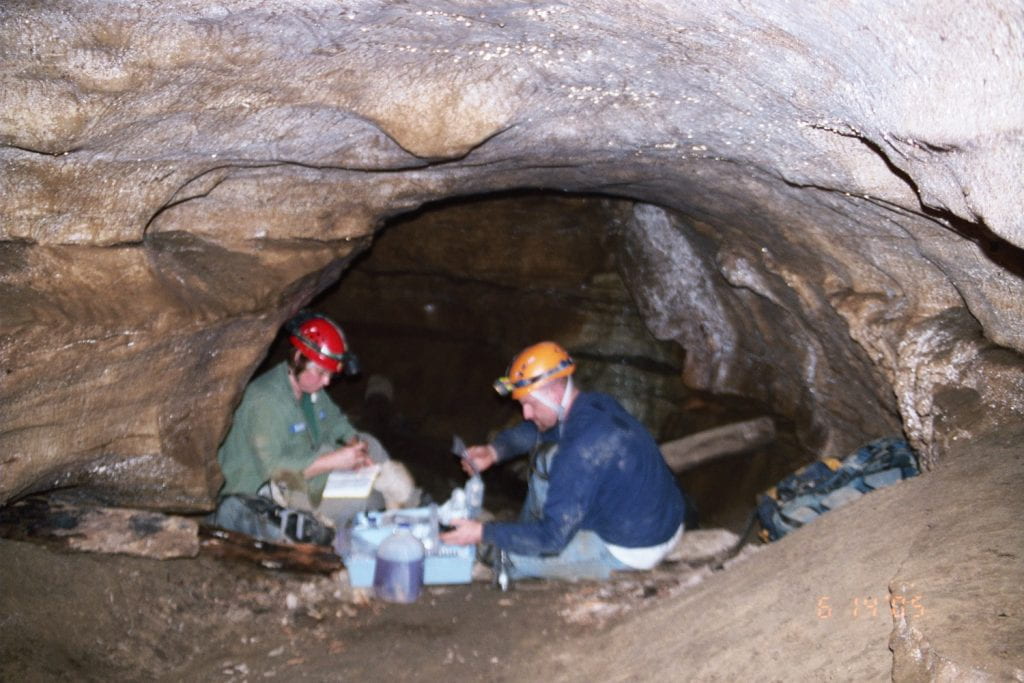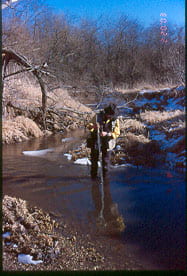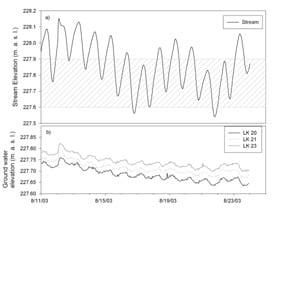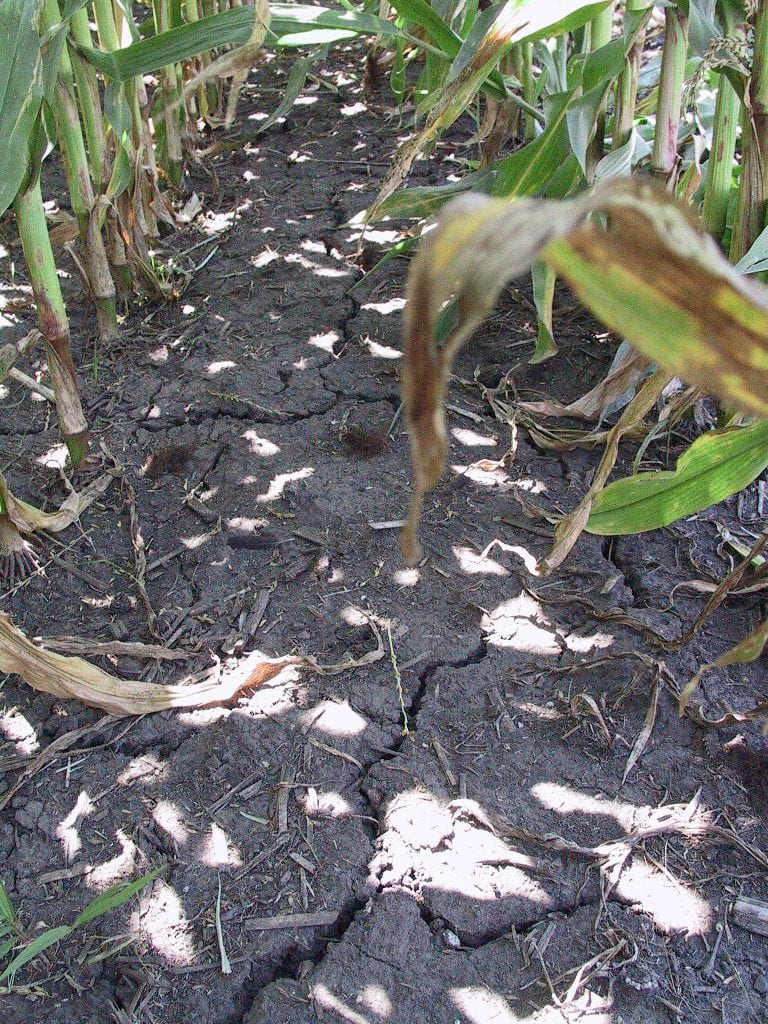My research interests focus on the interaction of surface water and ground water within two areas of interest: (1) the genesis of karst aquifers, and (2) heat transport and fluid flow through a glacial-fluvial aquifer. To address the questions I use hydrological tools to
- measure the physical parameters of the system, including hydraulic conductivity, stream geometry, and stream discharge,
- model the fluid flow and thermal flux within aquifer systems to gain an understanding of the controlling factors governing the movement of fluids through the system(s) of interest,
- determine the flow paths of fluids and solute(s).
My research group is currently focusing on four main topics: (1) Identifying the physical parameters that control surface water-ground water exchange in streams underlain by glacial deposits, (2) Modeling the thermal transport through a glacial-fluvial aquifer, (3) Assessing the pathways of fluid migration in a karst aquifer by evaluating the water chemistry, and (4) Surveying surface drainage and conduit geometry in karst aquifers.
Current and Past Projects
Fluid path delineation in the Horn Hollow section of Carter Caves State Park, Kentucky

In karst terrain, ground water is especially vulnerable to contamination from land-use activities because of the direct and rapid hydrologic link between surface water and ground water. When impacted surface water enters swallets, or storm-water runoff flows into a sinkhole, contaminants enter the ground water directly. The direct connection to the ground water eliminates the possibility of soil filtration, degradation, and sorption of the contaminant, making karst aquifers vulnerable to surface water impact. Assessing the risks to a karst system requires knowledge of the sources as well as the pathways the water flows. Unlike traditional porous media aquifers, karst systems are complex due to flow along bedding planes, fractures, and conduits. Understanding the flow with karst aquifers is an important step in preserving the integrity of the system, including the biological habitat.
Julie Angel’s (MS 2008) research focuses on identifying the various sources and pathways for the water moving through the Horn Hollow system in Carter Caves State Park in Kentucky. She has collected major ion samples from 15 locations within the Horn Hollow Valley during four sampling periods and is currently analyzing the geochemical data. A series of four questions defines the scope of her research: 1. Are there differences in Horn Hollow water chemistry parameters along the longitudinal profile of the stream? 2. Are there temporal differences in Horn Hollow water chemistry parameters? 3. Do the chemical ions within Horn Hollow waters provide information regarding flow paths and water contact with specific geological units within the valley? 4.

Are there similarities and/or differences between water chemistries of different karst regions, and if so, can they be used to identify evolutionary controls of a karst system? This research will contribute to the science of hydrogeology by analyzing the geochemical evolution of karst waters as they move down slope in a relatively pristine aquifer. It will also provide baseline parameters for futures studies that quantify water quality change as urbanization/development occurs in the area. Relating geochemical signatures to stratigraphic units within the valley will significantly increase our understanding of flowpaths within the system. Comparing Horn Hollow water chemistry with other karst systems will contribute additional data towards our understanding of the evolution of waters in karst systems.
evolutionary controls of a karst system? This research will contribute to the science of hydrogeology by analyzing the geochemical evolution of karst waters as they move down slope in a relatively pristine aquifer. It will also provide baseline parameters for futures studies that quantify water quality change as urbanization/development occurs in the area. Relating geochemical signatures to stratigraphic units within the valley will significantly increase our understanding of flowpaths within the system. Comparing Horn Hollow water chemistry with other karst systems will contribute additional data towards our understanding of the evolution of waters in karst systems.
Future projects will examine the development of the cave system and is tied to collaborative work with Toby Dogwiler at Winona State University. Advanced mapping and surveying techniques will be employed to determine the geometry and interconnectedness of the cave system. The overall project is investigating the origin and development of the karst system. The applicability of development models for Mammoth Cave and system of West Virginia is being explored for the Carter Caves area.
An additional line of research is being conducted to examine the contribution of sediment to conduit formation. Models of conduit development have treated the system as the interaction of water and carbonate rock and ignored the role of sediments. Sediments may have a duel role in conduit formation. They may both enhance dissolution during high flow and depress dissolution during low flow. During low flow regimes when the sediments are immobile, the pore waters may quickly become saturated with respected to calcium carbonate. If this occurs, then the carbonate rock beneath the sediments should be protected from dissolution unless the karst stream is able to mix under saturated water with the saturated pore water. On the other side, when flow is high enough to mobilize the sediments, then dissolution may be enhanced by the entrainment of abraded carbonate rock and by the increased surface area of the abraded wall or floor.
“Characterization of the streambed & the role the physical properties play on the Surface water”
– Groundwater exchange
The physical properties of the stream bed are being investigated to determine the frequency of particle movement. Theoretical calculations suggest that the bed of the Little Kickapoo Creek, which is a sand-gravel dominated bed of a third order stream, is highly mobile during moderate flow. Based upon two undergraduate students’ research from, the redistribution of the stream bed may play a role in the rate of surface water – ground water exchange. Work is currently being planned to study this hypothesis. A scour experiment has been developed to measure the frequency and magnitude of disturbances. Future questions will address the implications on thermal transport within the hyporheic zone.


Vanessa Drueke (MS 2008) is exmining the effect of streambed sediment grain size on temperature profiles of the hyporheic zone at two locations along a low gradient agricultural stream. The two sites feature different streambed sediment sizes, one consists predominantly of coarse sand and gravel, while the other is composed of fine sands and silt.
The primary hypothesis to be addressed is that streambed sediment size affects hyporheic zone temperatures. This overlying hypothesis has been broken into four smaller components, to be tested individually as outlined below.
Statement of Problem/ Objectives:
- Is the temperature profile in the hyporheic zone affected by stream bed sediment size, and if so, how?
- Are lateral temperature profiles different from longitudinal temperature profiles?
- Can temperature data be used to quantitatively define the lower boundary of the hyporheic zone in a low gradient stream?
- Does redistribution of stream sediments during storm events affect temperature profiles or alter the dominant mechanism, advection or conduction?
Vanessa’s work is being funded through student research grants from Sigma Xi and the Geological Society of America
A concurrent project examines the threshold of streambed sediment mobilization by measuring scour patterns at two sites located in the Little Kickapoo Creek (LKC), in McLean County , Illinois . The upstream grid (LKC1) is dominated by sand to gravel sized sediment, while the downstream grid (LKC2) is predominantly fine sand to silt with some gravel sized sediments. The scour study will give us insight into streambed mobilization in a low-gradient, third order, perennial, agricultural, stream setting.
The hypothesis of this study is that stream scour in the LKC is a function of flow velocity/discharge and sediment size. In order to test the hypothesis put forth the study will focus on the following questions.
Statement of Problem/ Objectives:
- What is the minimum velocity threshold needed to induce streambed scour?
- What is the maximum scour in relation to flow conditions and discharge?
- What is the rate of redeposition that occurs during reduced flow (base flow) conditions?
- Are the sediments that are redeposited the same size as those removed or is there variability?
- What is the relationship between flow velocity and scour rates?

Natural Stream Channels vs. Modified Stream Channels
While looking at the impacts of different land uses on a first order stream, Scott Maguffin (MS 2007) found that streams segments with higher sinuosity index values exhibited greater rates of denitrification. Building upon his work, Carol Glennon (MS 2008) is examining how the sinuosity of the Little Kickapoo Creek affects the removal of nitrogen from stream waters. She is monitoring six different sections of the Little Kickapoo Creek some of which retain natural meanders and some of which have been straightened. Using stream chemistry and discharge she is evaluating how the presence of nitrogen differs from areas that have been artificially straightened and those that retain their natural meanders.
“Differential Velocity as a control on the Surface water”
– Groundwater exchange

Hyporheic interchange is the small-scale (centimeters to hundreds of meters) flow of water between streams and groundwater through the interstitial spaces along stream beds and banks. One area of interest is the differential effect of stream flow velocities on hyporheic flow paths. Specifically: can a stream be gaining on the high-velocity cut bank side of a stream meander due to the Venturi effect of relatively high-velocity fluid flow, while losing on the opposite point bar due to nearly static pressure head? Current data show a difference in head values across a cross-section. The data also indicate that there is secondary processes controlling the flux.
Tim Sickbert (MS 2005) conducted research tested the hypothesis that velocity differences perpendicular to the direction of stream flow could cause pressure differences that result in surface water/ground water exchange. In his own words, “Can flowing water in a stream suck water out of the ground?”
Tim formulated his question on Bernoulli’s conservation of energy equation, which states that the energy of moving water is divided into gravitational and velocity components. At any point in a stream (i.e. the inside and outside of a meander), the total energy is the same. However, if the velocity components differ, then the gravitational (or pressure head) components must differ in order to conserve energy. So, the velocity differences may cause pressure head differences which may cause the flow of water across the stream bed.

To address his question, Tim installed nested piezometers in the stream bed and the stream banks, and has equipped them with pressure transducers. Tim’s data indicate that the velocity differential observed in the stream may be to low to produce a measurable pressure difference. The work has provided an initial study from which to build, including the possibility of numerical modeling of the exchange. While Tim’s work focused on two dimensions, future students will focus on three dimensions.
Tim’s research was funded by the Geological Society of America and Sigma Xi.
Stream water bypass through a meander neck, laterally extending the hyporheic zone

Hyporheic processes have been well documented in surface water-ground water mixing zones underlying and directly adjacent to streams. Meander necks may provide a further extension of the hyporheic zone. Head and temperature data collected from a set of wells across a meander neck show that stream water is moving through the meander neck. The hydraulic gradient across the meander neck is greater than the gradient for the stream; providing the potential for bypass. Rapid subsurface response to elevated stream stage shows a hydraulic connection between the stream and the subsurface. Temperature data show that heat is advected from the upstream to the downstream side of the neck. Together, the pressure and temperature data indicate that water moves across the meander neck. The inflow of stream water through the meander neck suggests that the meander system may host processes observed within hyporheic zones. We are currently working on a thermal model with which we plan to address question about the sources of the water that pass through a meander lobe. Stephen Williamson will be creating a 2-D thermal transport model of the area to determine the importance of the stream in transferring heat and to determine the role of the stream in the regional ground water pattern.

A current project is exploring the whether there is a relationship between sinuosity and nitrogen removal within a stream. Modification and channelization of streams in the Midwest and throughout the world is common. Little Kickapoo Creek (LKC) is no exception; some sections have been straightened and others retain natural meanders. The use of nitrogen fertilizers is a pollutant problem for streams and rivers in agricultural areas, such as LKC. Illinois alone contributes 19% of the nitrate load in the Mississippi River. In the hyporheic zone (HZ), where surface and ground water mix, microbial process control stream water chemistry and remediate excess anthropogenic nitrogen additions. The cycling of nitrogen in the HZ is regulated by interactive hydrologic, chemical, biologic and geologic factors. Buyck (ISU-2005) and Fromm (ISU-2005) both reported the reduction of nitrogen within waters as a result of HZ processes. Low gradient streams create increased HZ area as a result of the interaction beneath the meander lobes. This work will test the hypothesis that in stream segments with higher sinuosity nitrogen removal will be greater than in segments have been straightened.
Vertical nitrate transport in the unsaturated zone

Suzy Moore (MS 2005) quantified vertical nitrate transport rates below agricultural fields. Her results suggest that most of the transport occurs during normal opposed to wet soil conditions. Her data also indicate that crop cover, soil grain size, and organic matter content influence the amount of nitrate in the soil. Future questions examining the role of the individual topics will be addressed. If you are interested in this work let me know and I will provide you with greater detail.

Student Theses
Suzanna Moore (2005) “Nitrate transport in the unsaturated zone below agricultural fields.”
Timothy Sickbert (2005) “An examination into physical controls on hyporheic interchange.”
Brianne Jacoby (2011) “Uncovering the speleogenesis of the Carter Cave system in Carter County, KY.”
Anas B. Rabie (2014) “Integrating GIS and Hydrology for flood risk analysis.”
Kathryn Schroeder (2014) “Determining the source of anomalous segments in a karst stream.”
Lucas P. Chabela (2017) “Using 3-D modeling to describe the relationship between peak stage, storm duration and bank storage and the implications along along a meandering stream in central Illinois.”
Andrew Oberhelman (2019) “Chloride signature and transport in an urban-agricultural watershed.”
Patience Bosompemaa (2020) “Nitrate transport in the unsaturated zone.”
Abigail Heath (2021) “Natural nitrate removal in shallow subsurface stream flows”
Jake Riedel (2022) “Thermal controls on hyporheic flux and streambed flow dynamics”
Last updated July 12, 2022